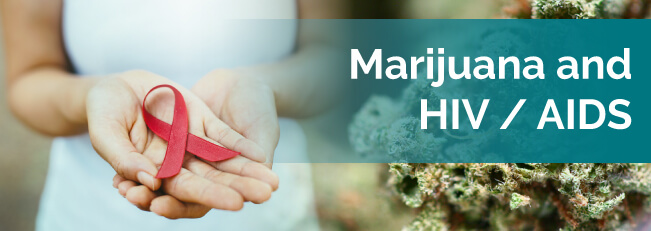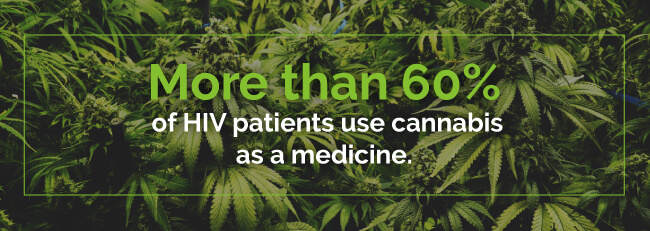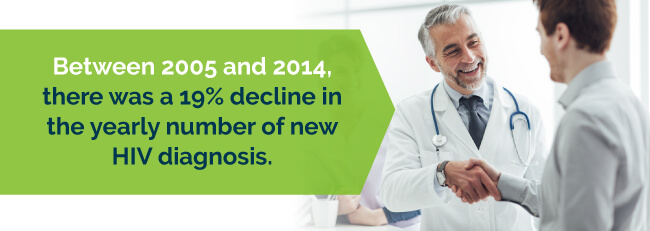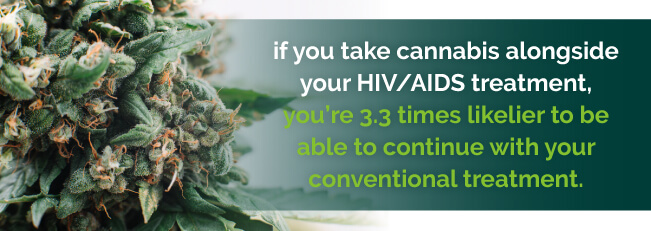
If you’re not sure where to turn after being diagnosed with HIV or AIDS or are wondering about your treatment options, we can help. Your symptoms may include weight loss, loss of appetite, and peripheral neuropathy. The side effects of the medications may include nausea, vomiting, anxiety and trouble sleeping, and they lead many patients to research the effectiveness of medical marijuana for HIV/AIDS. Understanding how medical cannabis for HIV/AIDS works will help you determine if it’s a suitable treatment option for you or a loved one.
According to the World Health Organization, over 500,000 Americans have died from HIV/AIDS, and over one million US citizens are living with the disease. It is a chronic, life-threatening condition that is one of the most commonly cited reasons cannabis patients get medical marijuana. In fact, each medical marijuana state includes HIV/AIDS as a qualifying medical condition.
Patients living with HIV typically take antiretroviral drugs to prolong the onset of AIDS. But side effects of antiretroviral therapy—which include nausea, vomiting, loss of appetite and severe pain in the nerve endings (polyneuropathies)—are often unbearable. Other side effects of HIV/AIDS include wasting syndrome or cachexia and intractable pain. Many patients use medical marijuana to help manage their symptoms. According to 2005 study published in the Journal of Acquired Immune Deficiency Syndromes, more than 60% of HIV patients use cannabis as a medicine.

Medical Marijuana is widely recognized as an effective treatment for symptoms of HIV/AIDS and the side effects related to the antiretroviral therapies that constitute the first line of treatment for HIV/AIDS. Its value as an anti-emetic (stops vomiting) and analgesic (relieves pain) has been proven in numerous studies and has been recognized by several government-sponsored reviews.
Medical marijuana for HIV/AIDS can help alleviate uncomfortable symptoms you may be experiencing from either the condition or its treatment.
White blood cells, which are produced in the bones, are a major component of the body’s immune system. When an infectious organism such as a virus or bacteria enters the body, the white blood cells are the first line of defense for destroying the invading organism. Infections with certain organisms however can have serious effects on the immune system. AIDS, or Acquired Immune Deficiency Syndrome, is a disorder that is caused by infection with the human immunodeficiency virus, HIV. This virus attaches to the surface of specific white blood cells called T cells and is therefore, able to reproduce and continue production of the virus. As more and more of the body’s healthy T cells become infected with HIV, the body’s immune system becomes compromised. As a result, if another foreign organism enters the body, the white blood cells are unable to fight the new infection and serious infection can result. In addition, there are many illnesses that persons infected with HIV are more susceptible for developing than are persons with healthy immune systems. A diagnosis of AIDS is made after T cell counts reach a dangerously low level and blood tests confirm the presence of antibodies to HIV, indicating that the virus is present in the body. Symptoms of AIDS may not appear for five to 10 years after being infected with HIV. Learn more below about how medical marijuana can help treat HIV / AIDS.
When people talk about HIV/AIDS, they’re discussing two separate yet interconnected conditions.
HIV stands for human immunodeficiency virus. When left undiagnosed and untreated, it can lead to AIDS (acquired immunodeficiency syndrome). Your body can fight certain viruses. However, it’s currently impossible for you to completely eliminate HIV from your system, which means that once you’ve contracted the virus, it’s with you for life.
HIV assaults your immune system, specifically your CD4 cells (T-cells), which are the cells that aid your body to fight infection. When the virus is left undiagnosed or untreated, you’re more susceptible to picking up infections or infection-related cancers. Given time, HIV can destroy so many of these good cells that your body can no longer ward off disease and infections. When this happens, you have AIDS, which is the final stage of HIV infection.
Although AIDS is the last stage of HIV infection, not everyone with the HIV advances to AIDS. AIDS occurs when your immune system is so severely damaged that opportunistic infections occur. When your immune system is healthy, you can be exposed to many different types of parasites, bacteria and viruses with no ill effects.
When you’re living with HIV/AIDS, the parasites, bacteria and viruses can pose serious threats to your health. Opportunistic infections take advantage of your weakened immunity and can cause devastating illnesses.
Medically speaking, AIDS occurs when your number of CD4 cells drops to less than 200 cells per cubic millimeter of blood. Your doctor can give you an AIDS diagnosis if you develop at least one opportunistic infection, no matter your CD4 count.
Studies have shown that a Central African chimpanzee is the source of HIV in humans. It’s believed that the chimpanzee strain of the virus, known as simian immunodeficiency virus (SIV), was most likely transmitted to people where it then mutated into the human version as a result of people hunting the animals for meat and encountering infected blood. It’s thought that this could have happened as far back as the late 1800s.
Through the years, HIV spread throughout Africa and reached the U.S. in the mid to late ‘70s.
If you feel you could have HIV, it’s imperative to get tested as soon as possible. Symptoms of HIV vary depending on the disease stage.
Some people suffer from a flu-like illness within a few weeks to a month of first being infected. Others have no symptoms at all. Flu-type symptoms may include:
The symptoms above can last from a few days to many weeks. Throughout this stage, an HIV test may not show as positive. However, you’re highly infectious and can spread the illness to others. Also, some HIV-positive individuals don’t have any symptoms for as long as a decade or more.
The next stage of HIV is the clinical latency stage, also known as chronic HIV infection. At this point, the virus continues to be active, but reproduces at low levels. When you have chronic HIV, you might only have mild symptoms or possibly none at all.
If you’re taking antiretroviral therapy (ART), the clinical-latency period can last ten years or more, or it can move forward more rapidly. You can transmit HIV during this phase, no matter how well you are. However, if you’re on ART, you’re less likely to give others the virus than people who are not virally suppressed.
If you have HIV and aren’t on antiretroviral therapy, the next stage is AIDS. Symptoms of AIDS may include:
If you want to know for sure you have HIV or AIDS, the only way to find out is to get tested.
When caught and managed early, people with HIV/AIDS can lead relatively normal lives. Dealing with the condition can be frightening and lonely. Luckily, there’s plenty of support available if you need help. Complementary therapies can often provide relief, and there’s possibly a respite from symptoms. Talk to a marijuana doctor about what medical cannabis for HIV/AIDS can do for you.
According to information from AIDS.gov, a site provided and managed by the Centers for Disease Control and Prevention:


Although these statistics are very sobering and show that people from all walks of life are at risk, the good news is that between 2005 and 2014, there was a 19 percent decline in the yearly number of new HIV diagnosis.
Once diagnosed with HIV or AIDS, people seek treatment.
HIV can be controlled with correct care and treatment. Your doctor will prescribe you antiretroviral therapy. If you’re diagnosed early and treated before the virus has time to advance and you remain on treatment, you can live a long life.
Nowadays, people are living full lives with the help of HIV medicines. The five main types are:
Although many conventional drugs show results, they often cause significant nausea, which then exacerbates the weight loss and loss of appetite already associated with the condition. Over time, nausea, loss of appetite and weight loss can lead to AIDS wasting syndrome, one of the leading causes of AIDS deaths.
Antiretrovirals also have potential side effects, such as severe nerve ending pain, trouble sleeping, vomiting, depression, mood changes and anxiety. Medical marijuana can help reduce and manage these symptoms.
An unfortunate issue that sometimes occurs in HIV-positive patients is that the virus mutates and produces variations of itself. The virus can then become drug resistant, so conventional treatments will fail.
When HIV progresses without treatment, and you develop AIDS, the median survival rate is three years. This statistic drops to one year if you’re suffering from an AIDS-related opportunistic illness. Therefore, it’s imperative to seek treatment as early as possible.
As many as a third of HIV/AIDS sufferers experience uncompromising pain due to their antiretroviral therapy. Other side effects include weight loss, appetite loss, vomiting and nausea. These problems can be so harsh that some patients may abandon their treatment entirely.
According to information from the Journal of Acquired Immune Deficiency Syndromes, if you take cannabis alongside your HIV/AIDS treatment, you’re 3.3 times likelier to be able to continue with your conventional treatment.

Marijuana/cannabis for HIV/AIDS seems to eliminate nausea, vomiting and appetite loss associated with HIV/ADS treatment. In turn, this allows you to stop losing weight while getting enough essential nutrients to support your body. Pot also targets the neuropathic pain you feel when undergoing drug therapy.
Additionally, recent research has shown that when you take marijuana, it inhibits the inflammation of the brain that’s associated with HIV/AIDS, as it stops the virus from attaching to your cells. It’s also been proven that cannabis can inhibit the virus replicating within your body.
According to the Institute of Medicine (IOM),”For patients such as those with AIDS or who are undergoing chemotherapy and who suffer simultaneously from severe pain, nausea, and appetite loss, cannabinoid drugs might offer broad-spectrum relief not found in any other single medication.”
Columbia University published clinical trial data in 2007 reporting that HIV/AIDS patients who inhaled cannabis four times daily experienced “substantial … increases in food intake … with little evidence of discomfort and no impairment of cognitive performance.” They concluded, “Smoked marijuana … has a clear medical benefit in HIV-positive [subjects].”
In 2008, researchers at the University of California at San Diego concluded that cannabis “significantly reduced neuropathic pain intensity in HIV-associated … polyneuropathy compared to placebo when added to stable concomitant analgesics. … Mood disturbance, physical disability, and quality of life all improved significantly during study treatment. … Our findings suggest that cannabinoid therapy may be an effective option for pain relief in patients with medically intractable pain due to HIV.”
Taking the above into consideration, medical marijuana is a positive and useful addition to your HIV/AIDS treatment.
There is a positive connection between marijuana/cannabis and HIV/AIDS. As the studies mentioned above have shown, it’s effective at treating many of the symptoms associated with the condition itself, as well as the side effects of antiretroviral therapy.
Medical cannabis is useful for:
There are numerous strains of medical pot that can give relief to you if you’re coping with HIV/AIDS. Perhaps the best way of ascertaining what will work best for you is to search for a dispensary and speak with a knowledgeable budtender.
The following strains are often used in the management of symptoms of the disease:
Keep in mind that dosages involve a significant element of trial and error — what works for someone else may not necessarily work for you. Regardless, there will likely be a strain available that brings you some relief.
When you inhale cannabis, via vaporizing or smoking, your dosing is flexible, and you’ll feel the benefits within minutes. If you ingest weed by mouth, you could be waiting for hours to feel the effects.
If you’re a first-time user of medical marijuana, vaporizing or smoking is probably your best avenue because you can quickly experience the effects. Once you’ve discovered the right dosage, you can then begin to experiment with taking pot orally, perhaps in the form of cookies or brownies.
If you suffer from HIV/AIDS and/or the side effects from HIV/AIDs treatments and are looking to find relief through medical marijuana, MarijuanaDoctors.com can help. The next step is to search for a medical marijuana doctor or dispensary today. We can connect you with hundreds of quality marijuana doctors across the country in all legal marijuana states and ensure you are in compliance with your state laws. Book an appointment today and let us help improve your quality of life!
Find A Doctor Find A Dispensary